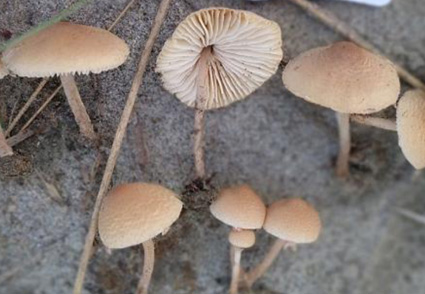Abstract
Lepiota sindhudeltana sp. nov. was found on sandy soil under Saccharum bengalense during fungal surveys to the deltas of the Indus River and the banks of the River Ravi, Punjab, Pakistan. The new species belongs to section Ovisporae, subsection Felininae and is characterized by dull orange appressed squamules on the pileus, thin pileal context, pale yellow lamellae, a stipe rounded to slightly oblong at base, basidiospores broadly ellipsoid to oblong, neither dextrinoid nor amyloid, short, clavate erect pileal hyphae, and narrowly clavate terminal hyphae of the stipitipellis. The closest described species to the new taxon in the phylogenetic tree, based on analysis of ITS and LSU sequences, is L. angusticystidiata. We present the new species with illustrated morphological description, phylogeny, and comparison with related or similar species.
References
<p>Bashir, H., Usman, M. & Khalid, A.N. (2020) <em>Lepiota cholistanensis</em> a new species of <em>Lepiota</em> (Agaricaceae: Basidiomycota) from Cholistan desert, Pakistan. <em>Phytotaxa</em> 455 (4): 267–276. https://doi.org/10.11646/phytotaxa.455.4.4</p>
<p>Bon, M. (1993) Flore mycologique d’Europe 3. Les <em>Lépiotes. Documents mycologiques</em>. <em>Mémoire hors série</em> 3: 1–153.</p>
<p>Bruns, T.D. (1995) Thoughts on the processes that maintain local species diversity of ectomycorrhizal fungi. <em>Plant Soil</em> 170: 63–73. https://doi.org/10.1007/BF02183055</p>
<p>Candusso, M. & Lanzoni, G. (1990) <em>Lepiota</em> s.l. <em>Fungi europaei</em> 4. Giovanna Biella, Saronno, 743 pp.</p>
<p>Gardes, M. & Bruns, T.D. (1993) ITS primers with enhanced specificity for Basidiomycetes-Application to the identification of mycorrhizae and rusts. <em>Molecular Ecology</em> 2: 113–118. https://doi.org/10.1111/j.1365-294X.1993.tb00005.x</p>
<p>Hall, T.A. (1999) BioEdit: a user-friendly biological sequence alignment editor and analysis program for Windows 95/98/NT. <em>Nucleic Acids Symposium Series</em> 41: 95–98.</p>
<p>Ijaz, M., Ahmad, H.R., Bibi, S., Ayub, M.A. & Khalid, S. (2020) Soil salinity detection and monitoring using Landsat data: a case study from Kot Addu, Pakistan. <em>Arabian Journal of Geosciences</em> 13 (13): 1−9.</p>
<p>Johnson, J. (1999) Phylogenetic relationships within <em>Lepiota</em> sensu lato based on morphological and molecular data. <em>Mycologia</em> 91: 443–458. https://doi.org/10.1080/00275514.1999.12061038</p>
<p>Kirk, P.M., Cannon, P.F., Minter, D.W. & Stalpers, J.A. (Eds.) (2008) <em>Ainsworth and Bisby’s Dictionary of the fungi, Wallingford</em>. International Mycological Institute, 784 pp. https://doi.org/10.1079/9780851998268.0000</p>
<p>Kühner, R. (1936) Recherches sur le genre <em>Lepiota. Société mycologique</em> <em>de France</em> 52: 75–238.</p>
<p>Liang, J.F., Yu, F., Lu, J.K., Wang, S.K. & Song, J. (2018) Morphological and molecular evidence for two new species in <em>Lepiota</em> from China. <em>Mycologia</em> 110: 494–501. https://doi.org/10.1080/00275514.2018.1464333</p>
<p>Munsell, A. (1994) <em>Soil color charts</em>. revised edition. Macbeth Division of Kollmorgen Instruments Corporation, New York.</p>
<p>Nawaz, R., Khalid, A.N., Hanif, M. & Razaq, A. (2013) <em>Lepiota vellingana</em> sp. nov. (Basidiomycota, Agaricales) a new species from Lahore, Pakistan. <em>Mycological Progress</em> 12: 727–732.</p>
<p>Niazi, A.R., Asif, M., Izhar, A. & Khalid, A.N. (2021) A new species of <em>Lepiota</em> (Agaricaceae) from Punjab, Pakistan. <em>Phytotaxa</em> 511: 163–174.</p>
<p>Qasim, T., Khalid, A.N., Vellinga, E.C. & Razaq, A. (2015) <em>Lepiota albogranulosa</em> sp. nov. (Agaricales, Agaricaceae) from Lahore, Pakistan. <em>Mycological Progress</em> 14: 24. https://doi.org/10.1007/s11557-015-1037-z</p>
<p>Qasim, T., Khalid, A.N. & Vellinga, E.C. (2016) A new species of <em>Lepiota</em>, <em>Lepiota lahorensis</em>, from Lahore, Pakistan. <em>Turkish Journal of Botany</em> 40: 419–426. https://doi.org/10.3906/bot-1507-31</p>
<p>Rambaut, A. (2014) FigTree 1.4. 2 software. Institute of Evolutionary Biology, University of Edinburgh. Rambaut, A., Suchard, M.A. & Xie, D. Tracer v. 1.6. Available from: http://beast.bio.ed.ac.uk/Tracer (accessed 9 January 2018)</p>
<p>Razaq, A., Khalid, A.N. & Vellinga, E.C. (2012a) <em>Lepiota himalayensis</em> (Basidiomycota, Agaricales), a new species from Pakistan. <em>Mycotaxon</em> 121: 319–325. https://doi.org/10.5248/121.319</p>
<p>Razaq, A., Khalid, A.N. & Ilyas, S. (2012b) <em>Tricholomopsis flammula</em> Métrod ex Holec (Basidiomycota, Agaricales), an addition to the mushroom flora of Pakistan based on molecular identification. <em>Pakistan Journal of Botany</em> 44: 413–416.</p>
<p>Razaq, A., Vellinga, E.C., Ilyas, S. & Khalid, A.N. (2013) <em>Lepiota brunneoincarnata</em> and<em> L. subincarnata</em>, distribution and phylogeny. <em>Mycotaxon</em> 126: 133–141.</p>
<p>Razaq, A., Ilyas, S. & Khalid, A.N. (2020) Molecular systematics and evolutionary relationships of some inland gilled basidiomycetes from the Himalayan moist temperate forests of Pakistan based on rDNA markers. <em>Pakistan Journal of Botany</em> 52: 1055–1063.</p>
<p>Schoch, C.L., Robbertse, B., Robert, V., Vu, D., Cardinali, G., Irinyi, L. & Federhen, S. (2014) Finding needles in haystacks: linking scientific names, reference specimens and molecular data for Fungi. <em>Database</em> 2014: 1–21.</p>
<p>Stallman, J.K., Hemmes, D.E., Hynson, N.A. & Shintaku, M.H. (2020) <em>Lepiota punaensis</em> sp. nov. from Hawai ‘i Island, and a discussion of <em>L. elaiophylla. Mycotaxon</em> 135: 471–489.</p>
<p>Stewart, R.R. (1972) An annotated catalogue of the vascular plants of West Pakistan and Kashmir.<em> In: </em>Nasir, E. & Ali, S.I. (Eds.)<em> Flora of Pakistan. </em>Fakhri Printing Press, Karachi<em>. </em></p>
<p>Usman, M. & Khalid, A.N. (2020) <em>Termitomyces acriumbonatus</em> sp. nov. (Lyophyllaceae<em>, </em>Agaricales) from Pakistan. <em>Phytotaxa</em> 477: 217–228. https://doi.org/10.11646/phytotaxa.477.2.6</p>
<p>Vellinga, E.C. (2001a) Studies in <em>Lepiota</em> III. Some species from California. <em>Mycotaxon</em> 80: 285–295. https://doi.org/10.3852/09-180.</p>
<p>Vellinga, E.C. (2001b) Agaricaceae.<em> In: </em>Noordeloos, M.E., Kuyper, T.W. & Vellinga, E.C. (Eds.) <em>Flora Agaricina Neerlandica</em> 5. Rotterdam: A.A. Balkema Publishers, 220 pp.</p>
<p>Vellinga, E.C., de Kok, R.P. & Bruns, T.D. (2003) Phylogeny and taxonomy of <em>Macrolepiota</em> (Agaricaceae). <em>Mycologia</em> 95: 442–456.</p>
<p>Vellinga, E.C. (2003) Phylogeny of <em>Lepiota</em> (Agaricaceae) evidence from nrITS and nrLSU sequences. <em>Mycological Progress</em> 2: 305–322. https://doi.org/10.1007/s11557-006-0068-x</p>
<p>Vellinga, E.C. (2004) Genera in the family <em>Agaricaceae</em>: evidence from nrITS and nrLSU sequences. <em>Mycological Research</em> 108: 354–377. https://doi.org/10.1017/S0953756204009700</p>
<p>White, T.J., Bruns, T., Lee, S. & Taylor, J. (1990) <em>Amplification and direct sequencing of fungal ribosomal RNA genes for phylogenetics. In: PCR protocols: a guide to methods and applications</em>. Academic Press, San Diego, 482 pp. https://doi.org/10.1016/B978-0-12-372180-8.50042-1</p>


